Plant Pests: Scale & Thrips and How To Control Them
When you buy your beautiful new plant, I bet you’re not thinking “what kind of pests will this get?” Pests seem to be be attracted to plants like Pooh to the honey pot. It’s good to be able to identify them and get a handle on things before the infestation escalates. This is all about those common plant pests scale and thrips and how to control them.
Both scale and thrips are sucking insects. They drink the sap (think of it like juice or blood) out of the plant. This deforms the foliage and flowers, slowly weakens the plant and can ultimately kill it. Scale you can see with the naked eye making them easy to identify but thrips are teeny tiny and you often don’t realize they’ve infested a plant until the damage is well on the way.
Scale
There are many different types of scale insects, mealy bugs being 1 of them. Here I’m going to be talking about soft and hard scales, which are found in a variety of shapes, colors and sizes. I’ve seen a lot of scale on plants, both indoors and out. Adult scales, as far as I know anyway, are visible to the eye making them easy to identify. Mealy bugs and aphids are easy to see also.
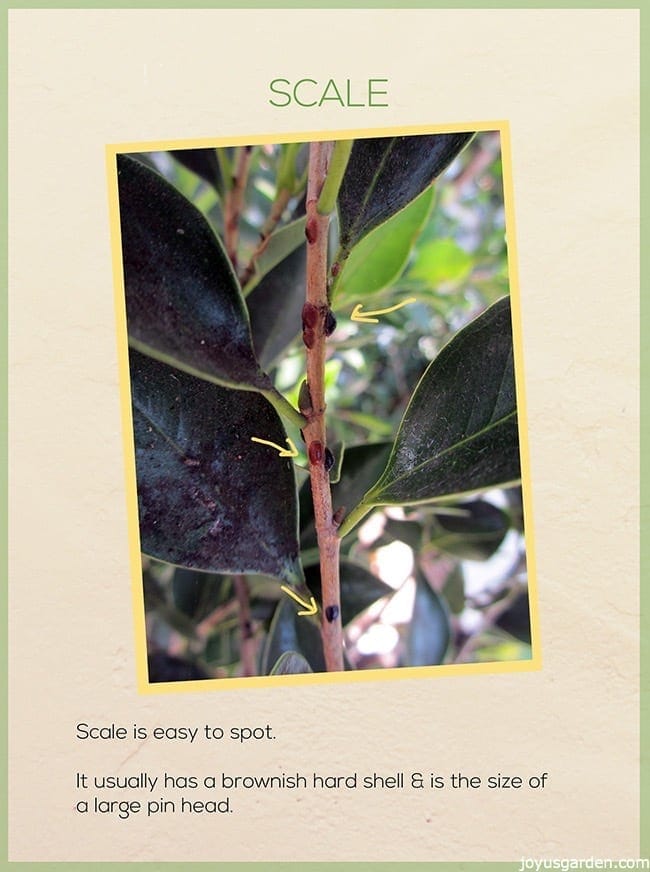
Soft scale, which is brown to tan in color, secretes sugar from the sap of the plant as it’s not able to ingest all of it. You might see a black mold on your infested plant which is a fungus growing on the sugar. Ants love that sugar and flock to the plant to feast on all that sweetness. The ants aren’t after the plant, they’re after the sugar. Once the pests are gone, the ants will go too. You want to hose that black sooty mold off your plant by the way.
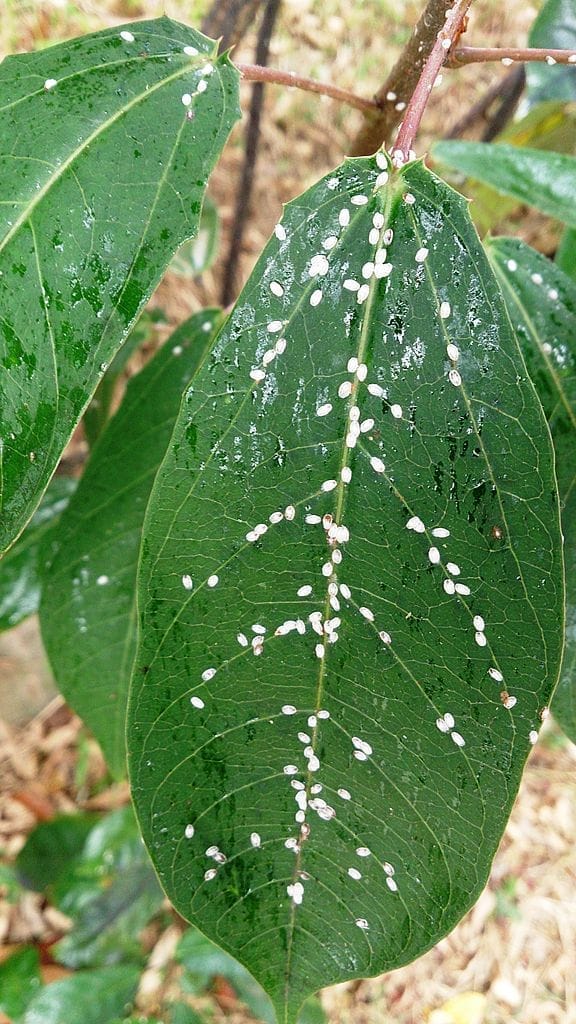
White Scale
Hard scale can be brown, white, tan, reddish or black. Scale looks like little bumps on your plant and is commonly found on the branches, stems, the undersides of the leaves and also on the fruit. I’ve seen scale on citrus trees, myoporums, different ficus’ both indoors and out, cycads, bamboo palms and holly.
Thrips
An interesting fact: whether you have 1 or 500, you still call it/them thrips. There is no singular. Thrips are teeny tiny, just like spider mites, making them almost impossible to detect until the damage has started or is well on its way. Just like the other pests, there are many different types of thrips.
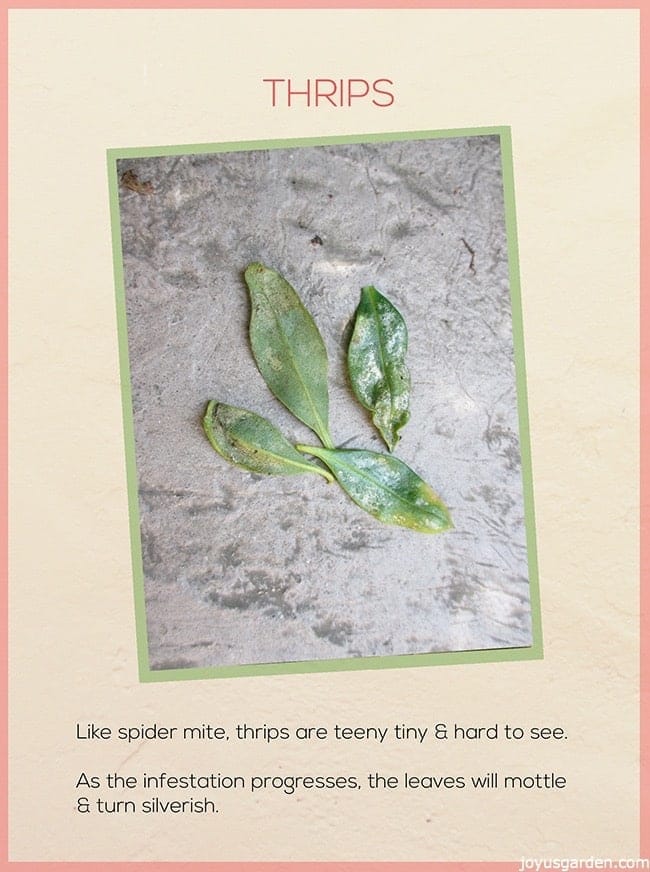
Most thrips are brown and some have wings and some don’t. The larvae, or the teenagers, are wingless. Thrips feed mainly on the upper surfaces of the leaves along with flowers, buds, fruits and vegetables. As the infestation progresses, the leaves will mottle, turn yellowish or silverish. The foliage will deform along with other parts of the plant too.
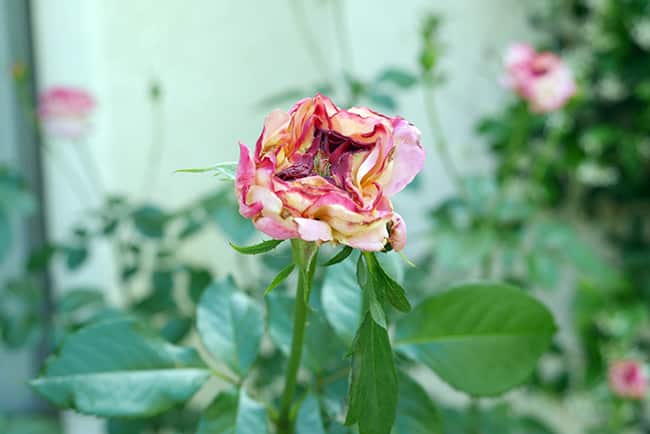
Here you see how Western Flower Thrips deformed the flower of my rose. They are brownish yellow or pale yellow. The buds are closed tight so can’t see the damage until the flower opens. Interestingly enough, the buds opening up now are just fine.
I’ve seen thrip damage on citrus, myoporums, rhododendrons, camellias, azaleas, gladiolas, ferns, roses, squash and dieffenbachia. If you prefer to grow your own, keep your eyes open for thrips (as well as spider mites) infesting pot.
How to control scale & thrips:
1) Predators.
Release lacewings in your garden as a method of control. This obviously isn’t a viable solution for your houseplants! There is a predatory mite which controls thrips. Both of these 2 predators eat the eggs & larvae which is a good way to prevent future infestations.
2) Spray with water using the garden hose, kitchen or bath spray.
This is the method I fall back on. You want to gently blast off (no fire hose action here please) the pests & their eggs. The spray in your kitchen or bathroom will be suitable for your houseplants if you don’t have access to a hose outdoors. For these 2 pests, this method is a partial control. You’ll get the many of the larvae & eggs.
3) Insect killer sprays.
I don’t use chemicals so these are considered to be “natural controls”. They include: horticultural oil, insecticidal soap & need oil. Most plants can be sprayed with these but just check 1st. You can do a little research & see which would best for you.
Here are some options: insecticidal soap ready to use, insecticidal soap concentrate, horticultural oil ready to use, horticultural oil concentrate, neem oil ready to spray & neem oil concentrate. This 1 lists itself as a houseplant & garden insect killer.
I’ve used the horticultural oil to get a handle on scale & it worked just fine. The oil coats the scale & smothers it.
4) Homemade spray recipes.
Here’s the way I’ve always made an soap/oil spray: Mix 1 tablespoon mild dish soap or Dr. Bronner’s, 1 tablespoon vegetable oil & 1 cup water. This works on the same principal as the horticultural oil.
5) Sticky Traps
I used sticky blue traps to get the adult thrips. Hang them in or right next to the infested plants. The thrips are attracted to blue & fly right into the sticky traps. I would spray the plants to make sure I got the larvae & eggs too.
6) Manuel control.
If the infestation isn’t bad, you can always scrape scale off with your finger nail (if that doesn’t creep you out!) or a rag or towel. When my bamboo palm had scale, I mixed up a solution of 1/2 rubbing alcohol with 1/2 water. I dabbed the scale off with a cotton swab. I sprayed the plant & the surface of the soil with that solution (diluted down with more water) to make sure I got the eggs.
Things to know about scale, thrips & their control:
* Scale is usually easy to spot with the naked eye, thrips aren’t.
* Control these pests as soon as you see them. Once the infestation gets bad, they’re hard to get rid of. Your plant may not recover.
*Ants are after the sugar residue left behind by the soft scale. Once they’re gone, the ants will be too.
*The leaves of the plant can get sticky – that’s caused by the sugar secretion. You might see a black residue (the fungus) appear – you’ll want to get rid of that too.
*If you choose to spray as your method of control, you’ll need to repeat. Follow the instructions on the bottle as to how often. A homemade spray you can repeat every 7 days. It might take 3-4 rounds to control the pests. Make sure the plant isn’t stressed (ie bone dry) before spraying. And, don’t spray in the hot sun.
*It’s very, very, very important to spray the undersides of the leaves thoroughly. That’s where pests like to hang out.
*If your infestation is bad, clean up & destroy any plant debris on the ground. Spray the surface of the soil to make sure you get any eggs.
*Be sure to inspect any new plants you bring home to make sure they’re not carrying any pests.
*The same goes for plants which have summered outdoors. Check them for pests before bringing them in for the colder months.
Hopefully, your plants never get scale or thrips, but if they do, now you can identify them and take action.
Happy (pest free) gardening & thanks for stopping by,

You May Also Enjoy:
How To Control Plant Pests (Spider Mites & Whiteflies)
How To Control Plant Pests: Fungus Gnats & Root Mealybugs
Lucky Bamboo & Spider Mites: How To Control This Common Plant Pest

This post may contain affiliate links, you can read our policies here.
- About the Author
- Latest Posts
Nell, the founder of Joy Us garden, was born into a gardening family and grew up in Connecticut’s countryside. After living in Boston, New York, San Francisco, & Santa Barbara, she now calls the Arizona desert home. She studied horticulture & garden design, working in the field all her life. Nell is a gardener, designer, blogger, Youtube creator, & author. She’s been gardening for a very long time & wants to share what she’s learned with you.

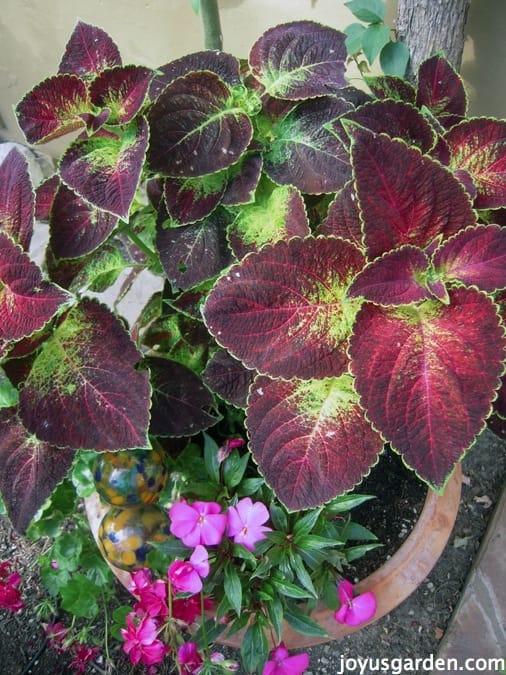
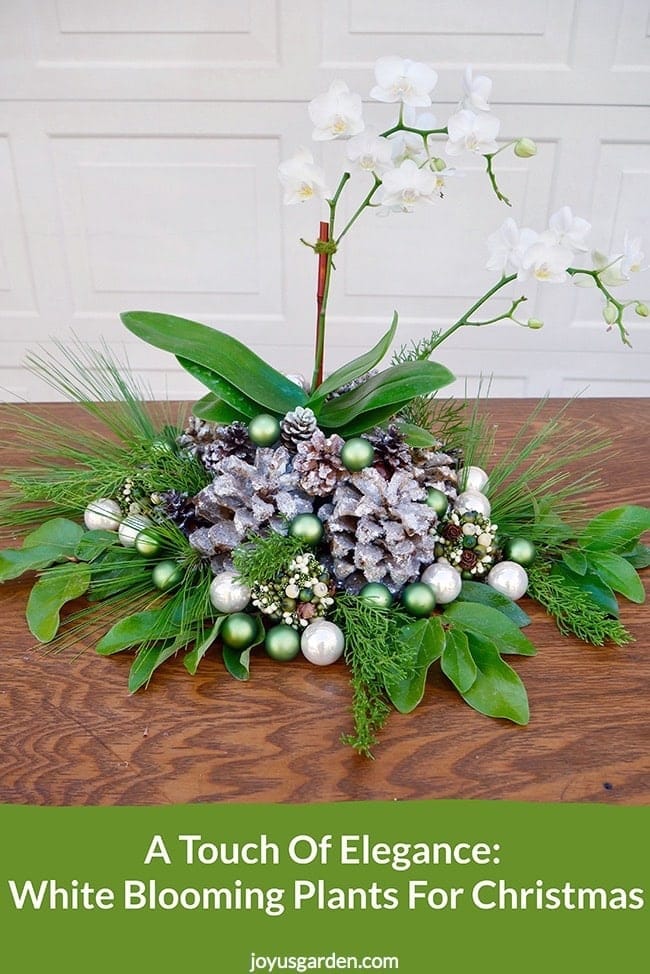



Thank you this is useful and informative
You’re very welcome Rimonah. Glad you found it to be helpful. Nell